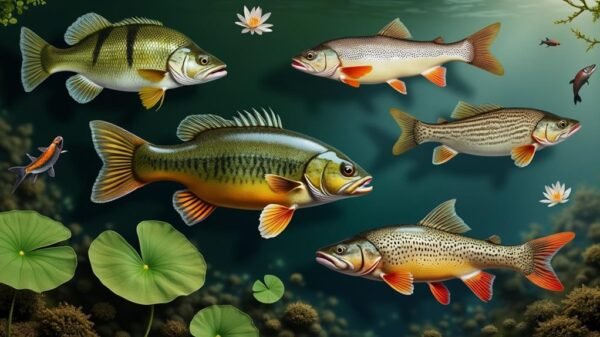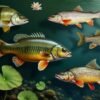Identifying freshwater fish species effectively matters because it helps you understand aquatic ecosystems better. Each fish plays a unique role, influencing the health of their waters. Knowing your local species raises your appreciation for biodiversity and boosts your fishing skills, ensuring sustainable practices. Different fish thrive in varied habitats like rivers, lakes, and wetlands, so recognizing these can deepen your insights. Plus, understanding local regulations can keep fish populations healthy and thriving. These skills not only make you a more conscientious angler, but they also connect you more closely with nature. There's so much more to uncover about this exciting topic!
Importance of Fish Identification
Identifying freshwater fish species is essential for understanding aquatic ecosystems. Each fish species contributes uniquely to the ecosystem, influencing factors such as insect populations and serving as prey for various wildlife. For example, knowing about popular species like Largemouth Bass and Trout enhances your appreciation for local biodiversity. By recognizing different fish, you gain valuable insights into the health of water bodies.
Familiarity with fish species enables informed decisions during fishing trips. You learn which species are plentiful, which are endangered, and how to protect their habitats. This awareness promotes sustainable fishing practices, ensuring that future generations can experience these aquatic treasures.
Moreover, fish identification can enhance outdoor activities. Whether you're fishing, kayaking, or simply exploring, spotting different fish species adds excitement to your adventures. It fosters a deeper connection with nature. Grab a guidebook, explore the waters, and let your curiosity lead you. You'll not only improve as an angler but also become a guardian of aquatic environments.
Common Freshwater Fish Species

Identifying common freshwater fish species can greatly enhance your outdoor activities and deepen your awareness of local ecosystems. When you venture to lakes or rivers, familiarity with a few notable fish can elevate your experience. For example, the bass, particularly the Largemouth Bass, is a popular choice among anglers due to its spirited nature and delicious fillets. This species is one of the most plentiful fish worldwide, making it a primary focus for freshwater fishing enthusiasts.
You may also spot the Sunfish, characterized by its vibrant colors, often inhabiting ponds and small lakes. Another significant species is the Catfish, recognized for its whisker-like barbels and preference for bottom-dwelling environments. If you find yourself near a river, keep watch for Trout, which thrive in cold, clear waters and are prized by many anglers. Each of these species plays a vital role in maintaining the health of aquatic ecosystems, contributing to the intricate balance of life in freshwater habitats.
Key Physical Characteristics

Key physical traits of freshwater fish can help you quickly and accurately identify various species. When observing a fish, start by assessing its size and shape. Some species, like the elongated Northern Pike, have streamlined bodies, while others, such as the rounded Bluegill, display a more compact form. These distinctions can significantly narrow your options.
Freshwater fish can also be categorized based on temperature preferences, influencing their physical attributes. For example, coldwater species, including Rainbow Trout, often possess sleek bodies that facilitate movement through cooler waters. In contrast, warm-water varieties, like Largemouth Bass, tend to exhibit rounder shapes.
Next, focus on coloration. Bright hues may signify a breeding male, while muted tones typically indicate a female or juvenile fish.
Don't forget to examine the fins! The quantity and type of fins can differ widely among species. For instance, the Betta fish features long, flowing fins, whereas the stout-bodied Crappie has shorter, sturdier ones. Pay attention to body patterns as well. Stripes, spots, and solid colors serve as important identifiers.
The mouth's positioning is another critical feature. Some species, like the Catfish, are equipped with whisker-like barbels, while others, such as the Walleye, have more pronounced snouts. By synthesizing these traits—size, shape, color, fins, body patterns, and mouth structure—you'll form a clearer picture of the fish before you. Prepare yourself to dive into the fascinating world of native freshwater fish species identification.
Freshwater Fish Habitats

Understanding the physical traits of freshwater fish lays a foundation for examining their habitats. Each fish species has a distinct environment that caters to its requirements, and recognizing these habitats aids in spotting and identifying them. Freshwater fish, such as those featured in the various collections related to species like *Salmo trutta* (trout) and *Micropterus* (bass), have adapted to flourish in specific ecosystems. Here are three essential types of freshwater fish habitats to consider:
- Rivers and Streams: These flowing aquatic systems host species that thrive in moving water. Look for fish such as *Salmo trutta* and *Micropterus salmoides*, which favor areas rich in oxygen and natural cover.
- Lakes and Ponds: These still water bodies provide diverse environments, ranging from the shallow peripheries to the deep central zones. Species like *Lepomis macrochirus* (bluegill) and *Ictalurus punctatus* (catfish) often inhabit these areas, benefiting from the varied structures of aquatic plants and rocks.
- Wetlands: These biodiverse regions serve as crucial breeding habitats. Fish such as *Esox lucius* (pike) and *Perca fluviatilis* (perch) are commonly found in these lush environments, where they can conceal themselves from predators.
Local Regulations and Techniques

Before casting your line, familiarize yourself with local fishing regulations. These guidelines protect fish populations and habitats, ensuring sustainable angling for future generations. Different methods for fishing in lakes, rivers, and ponds can enhance your experience, so understanding the unique characteristics of each environment is essential. Check for restrictions on fish sizes and species, as well as designated fishing seasons. Ignoring these rules can result in penalties, so take a moment to review them.
Once you're aware of the regulations, focus on techniques that can elevate your fishing outings. Use lures that imitate local bait fish, and experiment with various colors and sizes. Keep your tackle box stocked with essentials like Eagle Claw hooks, Berkley weights, and premium fishing line—this preparation allows you to adapt to changing conditions effectively.
Additionally, practice catch and release. This method helps maintain healthy fish populations while allowing you to enjoy the sport without depleting resources. By understanding local guidelines and employing effective techniques, you'll discover that fishing can be both fulfilling and sustainable. So gear up, respect the water, and embark on your fishing adventure.



























